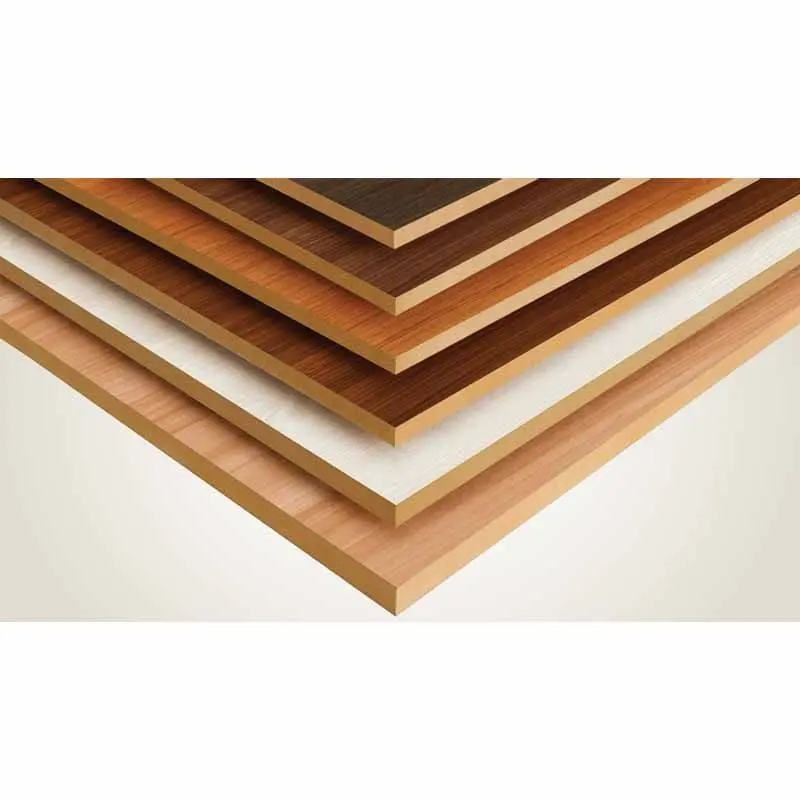Melamine board, abbreviated as MDF, is a full name for melamine impregnated film paper faced artificial board. It is a decorative board made by immersing paper with different colors or textures in melamine resin adhesive, drying it to a certain degree of curing, and then laying it on the surface of particleboard, moisture-proof board, medium density fiberboard, plywood, wood veneer, multi-layer board, or other hard fiberboard and pressing it with heat. During the production process, it is generally composed of several layers of paper, the number of which depends on the purpose.
The decorative paper is soaked in melamine solution and then pressed on with heat. Therefore, the moisture-proof board used for making furniture is generally called melamine moisture-proof board, and melamine formaldehyde resin is a solution with very low formaldehyde content, which is environmentally friendly. Sticking it on not only does not cause secondary pollution but also reduces the release of the base material inside.
Characteristics of melamine decorative board:
1, Can imitate various patterns, with bright colors, used as veneers for various artificial boards and woods, with high hardness, wear resistance, and good heat resistance.
2, Generally resistant to chemicals, able to withstand the erosion of common acids, alkalis, oils, and alcohols.
3, The surface is smooth and glossy, easy to maintain and clean. Melamine boards have excellent properties that natural wood does not possess, so they are often used for interior construction and decoration on various furniture and cabinets.
Composition:
"Melamine" is one of the resin adhesives used in the production of this type of board. After different colored or textured paper is soaked in the resin and dried to a certain degree of curing, it is laid on the surface of particleboard, medium density fiberboard, or hard fiberboard and formed into decorative panels by hot pressing. The standard name is melamine impregnated paper film faced artificial board, and calling it melamine board actually reveals part of its decorative composition. It is generally composed of surface paper, decorative paper, covering paper, and base paper.
① The surface paper is placed on the top layer of the decorative board, serving as a protective layer for the decorative paper, making the surface of the board highly transparent after heating and pressing, and hard and wear-resistant. This paper requires good water absorption properties, whiteness, and transparency after impregnation.
② The decorative paper, also known as wood grain paper, is an important component of the decorative board, with or without a base color, and is printed with various patterns. It is placed below the surface paper and mainly serves a decorative function. This layer requires the paper to have good covering power, impregnation properties, and printing performance.
③ The covering paper, also known as titanium white paper, is generally placed below the decorative paper when manufacturing light-colored decorative boards to prevent the phenolic resin from the base from penetrating to the surface. Its main function is to cover the color spots on the base material surface. Therefore, it requires good covering power. These three types of paper are all impregnated with melamine resin.
The base paper, which is the underlying material of the decorative panel, plays a role in the mechanical properties of the board. It is made by impregnating phenolic resin and drying, and the number of layers can be determined according to the purpose or thickness of the decorative panel. When selecting this type of furniture, in addition to being satisfied with the color and texture, the appearance quality can also be distinguished from several aspects. Check for stains, scratches, indentations, and pores, whether the color and luster are even, and whether there are bubbles, local paper tearing, or damage.
Melamine board is a type of wall decorative material. Some people use melamine board to counterfeit composite flooring for ground decoration, which is not appropriate. The surface is flat, it is not easy to deform because the expansion coefficient of the board on both sides is the same, the color is bright, the surface is more wear-resistant and corrosion-resistant, and the price is economical. It can be freely imitated various patterns, with bright colors, used as the veneer of various artificial boards and woods, with high hardness, wear resistance, and good heat resistance.
It has good resistance to chemical substances and can resist the erosion of general acids, bases, greases, and alcohols. The surface is smooth and shiny, and it is easy to maintain and clean.

Post time: Apr-01-2025
